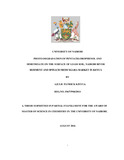| dc.description.abstract | This research endeavours to investigate the photo-degradation of pentachlorophenol and Dimethoate by incandescent bulbs and fluorescence light on Nairobi river sediment, Limuru loam soil and spinach leaf surface. This is because Most of research done in pesticides show that herbicides, fungicides and insecticides tend to persist in the environment mainly soil, water, or air for a long time.
It is therefore necessary to determine their possible decomposition using different light energies and extent of exposure time, which may lead to possible harmless compound.
The research was done by applying 0.01g of each of the pesticide to 1.0g of the river sediment, loam soil and 5cm by 5cm spinach leaf surface. Then it was shaken thoroughly for five minutes. Thereafter the mixture was exposed to sunlight, 40w, 60w, 75w and 100w incandescent bulbs at 10, 20, 30, 60 and 120 minutes after which the set-up was allowed to stabilize for an hour. The stabilized set-up was washed with 2ml of analytical grade acetone. Then it was analysed for pesticide level using Shimadzu UV-Visible spectrophotometer at 322nm and 229nm for Pentachlorophenol and Dimethoate respectively. This procedure was repeated using 9w, 11w, 15w and 20w fluorescence tubes in place of incandescent bulbs. The procedure was repeated three times to obtain consistence results for statistical purpose. The data obtained was recorded, analysed and interpreted using Minitab 17 and Microsoft Excel statistical software’s.
The research revealed that, photo-degradation of both pentachlorophenol and dimethoate depends on the surface of exposure, light intensity, temperature among other factors. The 100W incandescent bulbs and 20w fluorescent tubes degraded both molecules mostly due
to the high number of photons striking the molecules, which causes photochemical reactions.
Spinach leaf surface is flat and well defined thus pesticide molecules are evenly exposed to radiation hence high degradation rate. The lower levels of both pesticides in Limuru loam soil are attributed to adsorption and photo-degradation processes.
In both pesticides, first order kinetics was followed. This is based on the high regression values obtained by the plots of natural logarithms of concentration versus time. The half-lives of both molecules on the three-exposure surface ranged between 0.007306 to 0.076days for PCP in incandescent bulb and 0.078 to 0.093 days for fluorescence light while the range of half-life is 0.037 to 0.00446 and 0.0023 to 0.013 days for DM in incandescent bulb and fluorescence light respectively. This was also dependent on the light intensity, surface of exposure and radiation time. | en_US |



